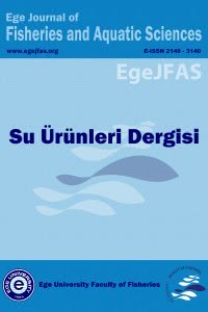Balık sos teknolojisi
fermente gıdalar, balık (gıda), soslar, gıda bozulması, deniz ürünleri
Fish sauce technology
fermented foods, fish, sauces, food spoilage, seafoods,
___
Beddows C.G., ismail M. and Steinkraus K.H. 1976. The use of bromelain in the hydrolysis of mackerel and the investigation of fermented fish aroma. J.Food Technol. 11:379-388.Beddows C.G. 1985. Fermented fish and fish products. Microbiology of Fermented Foods. Vol.2, Brian J.B. Wood, Ed. Elsevier Applied Science Publishers LTD, England, ISBN: 0-85334-333-0.
Cha Y.J. and Cadwallader K.R. 1998. Aroma -"Active compounds in skipjack tuna sauce. J. Agric.Food Chem. 46:1123-1128.
Chan T.Z., K"sev D. 1993. Influence of 'technological factors on autohydrolysis in fish. Khranitelna Promishlenost, 42 (5/6):38- 40.
Çaklı Ş. 1999. Proteolitic Enzyme Activities in rSome Fishery Products (Catepsin D and Casein Test).Tr.J.of Veterinary and Animal Sciences 23:385-390. (in turkish)
Gasaluck P., Yokayama K., Kimura T., Sugahara I. 1996. Some chemical and microbiological properties of Thai fish sauce and paste. J. Antibac. And Antifun. Agents 24 (6):385-390.
ICMSF. 1998. Mikroorganisms in Foods 6. Spices,dry soups and oriental flavorings. Blackie Academic & Professional, London, 615p.
Ijong F.G., and Ohta Y. 1995a. Microflora and chemical assessment of an Indonesian traditional fermented fish sauce 'bakasang'. J. Fac. App.Biol.Sci. 34 (2): 95-100.
Ijong F.G.,Ohta Y. 1995b. Characteristics of bakasang fermented with lactic acid bacteria mixed culture. J.Fac.App.Biol.Sci.
Ijong F.G., and Ohta Y. 1996. Physicochemical and microbiological changes associated with Bakasang processing -a traditional Indonesian fermented fish sauce. J. Sci.Food Agr.71(l): 69-74.
Karaibrahimoğlu Y. 1992. Utilization of shrimp heads and shells as raw material for shrimp sauce processing and animal feeding. Doktora tezi. Ege Üniversitesi Fen Bilimleri Enstitüsü Su Ürünleri Anabilim dalı. Bornova-İzmir, 140 p.(in turkish)
Kim S.M. 1999. The effects of koji and sucrose on the manufacture of Allaska pollack scrap sauce. Food Science and Biotechnology 7 (4): 242-247.
Nielsen H.H. 1995. Proteolytic enzyme activities in salted herring during cold storage. Ph.D. Department of Biotechnology Technical University of Denmark, 131 p.
Nongnuch R. 1987. Role of protein degradation in fermentation of fish sauce. Ph.D. Memorial University of Newfoundland (Canada) 120 p.
Owens J.D. and Mendoza L.S. 1985. Enzimically hydrolyzed and bacterially fermented fishery ProductsJ. Food Technol. 22:105-114.
Peralta R.R., Shimoda M and Osajima Y. 1996. Further identification of volatile compounds in fish sauce. J.Agric. Food Chem. 44: 3606-3610.
Ravikim C, Smith J.P., Simpson B.K. 1993. Production of fish sauce and acceleration of sauce fermentation using proteolytic enzymes. J.Aquat.Food Prod.Techn.2 (3):59-77.
Sanceda N.G., Kurata T. and Arakawa N. 1990. Overall quality and sensory acceptance of a lysine- fortified fish sauce. J. Food Sci.55:983-988.
Sanceda N.G., Kurata T, Suzuki Y and Arakawa N. 1992. Oxygen effect on volatile acids formation during fermentation in manufacture of fish sauce.J.Food Sci.57 (5): 1120-1122,1135.
Sanceda N.G., Kurata T and Arakawa N. 1996. Accelerated fermentation process for the manufacture of fish sauce using histidine . J.Food Sci. 61:220-225.
Sanceda N.G., Suzuki E, Ohashi M., Kurata T. 1999. Histamine behavior during the fermentation process in the manufacture of fish sauce. J.Agric.Food Chem. 47: 3596-3600.
Shimoda M., Peralta R.R ,Osajima Y. 1996. Headspace gas analysis of fish sauce. J.Agric.Food Chem. 44:3601-3605.
Thongthai C, McGenity T.J., Suntinanalert P.,Grant W.D. 1992. Isolation and characterization of extremely halofilik archaeobacterium from traditionally fermented Thai fish sauce (nam pla). Lett. in App.Mic.l4(3):lll-114.
Van Veen, A.G. 1965. Fermented and dried sea-food products in South-East Asia. In Fish as Food , Vol.3, G. Borgstrom, Ed. p.227-250. Academic Press, NewYork.
- ISSN: 1300-1590
- Yayın Aralığı: 4
- Başlangıç: 1984
- Yayıncı: Aynur Lök
Quality changes of sardine (Sardine pilchardus W.,1792) during frozen storage
BERNA KILINÇ, ŞÜKRAN ÇAKLI, Dugu KIŞLA
Ağ kafes üniteleri etrafındaki balıkların kaldırma ağı ile avcılığı üzerine bir ön çalışma
UĞUR ALTINAĞAÇ, UĞUR ÖZEKİNCİ, Cenkmen R. BEĞBURS
Tubifex tubifex Müller,1774 (Annelidae)'in besin kompozisyonu
MAHMUT YANAR, Yasemen YANAR, M. Ayçe GENÇ
M. Ziya Lugal GÖKSU, FATMA ÇEVİK, ÖZLEM FINDIK, Ercan SARIHAN
Total ve besin maddesi sindirilme oranlarının su ürünleri yetiştiriciliğindeki önemi
MURAT YİĞİT, SERAP USTAOĞLU TIRIL
Tavşan balığı (Siganus luridus Rüppell,1828) yetiştiriciliği
ŞÜKRAN ÇAKLI, Bahar TOKUR, UFUK ÇELİK, LATİF TAŞKAYA
Olta balıkçılığında düz ve çapraz iğnelerin av etkinliği üzerine bir araştırma
